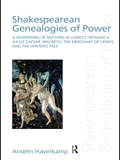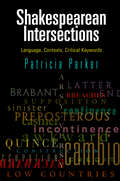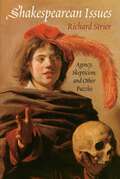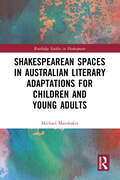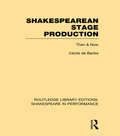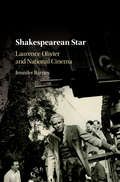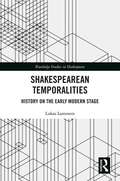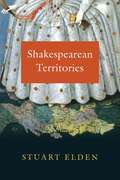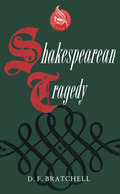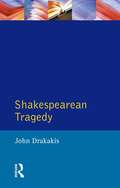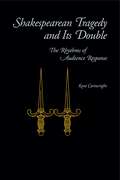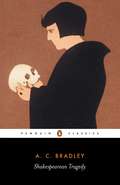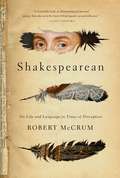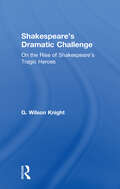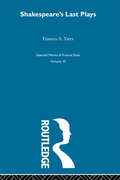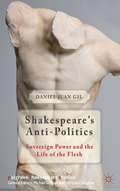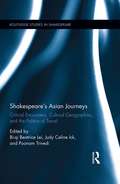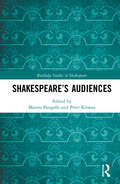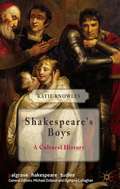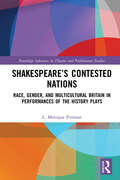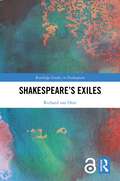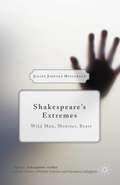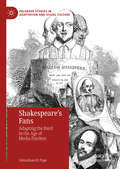- Table View
- List View
Shakespearean Genealogies of Power: A Whispering of Nothing in Hamlet, Richard II, Julius Caesar, Macbeth, The Merchant of Venice, and The Winter’s Tale
by Anselm HaverkampShakespearean Genealogies of Power proposes a new view on Shakespeare’s involvement with the legal sphere: as a visible space between the spheres of politics and law and well able to negotiate legal and political, even constitutional concerns, Shakespeare’s theatre opened up a new perspective on normativity. His plays reflect, even create, "history" in a new sense on the premises of the older conceptions of historical and legal exemplarity: examples, cases, and instances are to be reflected rather than treated as straightforwardly didactic or salvific. Thus, what comes to be recognized, reflected and acknowledged has a disowning, alienating effect, whose enduring aftermath rather than its theatrical immediacy counts and remains effective. In Shakespeare, the law gets hold of its normativity as the problematic efficacy of unsolved – or rarely ever completely solved – problems: on the stage of the theatre, the law has to cope with a mortgage of history rather than with its own success story. The exemplary interplay of critical cultural and legal theory in the twentieth-century – between Carl Schmitt and Hans Kelsen, Walter Benjamin and Ernst Kantorowicz, Hans Blumenberg and Giorgio Agamben, Robert Cover and Niklas Luhmann – found in Shakespeare’s plays its speculative instruments.
Shakespearean Intersections: Language, Contexts, Critical Keywords (Haney Foundation Series)
by Patricia ParkerWhat does the keyword "continence" in Love's Labor's Lost reveal about geopolitical boundaries and their breaching? What can we learn from the contemporary identification of the "quince" with weddings that is crucial for A Midsummer Night's Dream? How does the evocation of Spanish-occupied "Brabant" in Othello resonate with contemporary geopolitical contexts, wordplay on "Low Countries," and fears of sexual/territorial "occupation"? How does "supposes" connote not only sexual submission in The Taming of the Shrew but also the transvestite practice of boys playing women, and what does it mean for the dramatic recognition scene in Cymbeline?With dazzling wit and erudition, Patricia Parker explores these and other critical keywords to reveal how they provide a lens for interpreting the language, contexts, and preoccupations of Shakespeare's plays. In doing so, she probes classical and historical sources, theatrical performance practices, geopolitical interrelations, hierarchies of race, gender, and class, and the multiple significances of "preposterousness," including reversals of high and low, male and female, Latinate and vulgar, "sinister" or backward writing, and latter ends both bodily and dramatic.Providing innovative and interdisciplinary perspectives on Shakespeare, from early to late and across dramatic genres, Parker's deeply evocative readings demonstrate how easy-to-overlook textual or semantic details reverberate within and beyond the Shakespearean text, and suggest that the boundary between language and context is an incontinent divide.
Shakespearean Issues: Agency, Skepticism, and Other Puzzles
by Richard StrierIn Shakespearean Issues, Richard Strier has written a set of linked essays bound by a learned view of how to think about Shakespeare’s plays and also how to write literary criticism on them. The essays vary in their foci—from dealing with passages and key lines to dealing with whole plays, and to dealing with multiple plays in thematic conversation with each other. Strier treats the political, social, and philosophical themes of Shakespeare’s plays through recursive and revisionary close reading, revisiting plays from different angles and often contravening prevailing views.Part I focuses on characters. Moments of bad faith, of unconscious self-revelation, and of semi-conscious self-revelation are analyzed, along with the problem of describing characters psychologically and ethically. In an essay on “Happy Hamlet,” the famous melancholy of the prince is questioned, as is the villainy of Rosencrantz and Guildenstern, while another essay asks the reader to reconsider moral judgments and negative assessments of characters who may be flawed but do not seem obviously wicked, such as Edgar and Gloucester in King Lear.Part II moves to systems, arguing that Henry IV, Measure for Measure, and The Merchant of Venice raise doubts about fundamental features of legal systems, such as impartiality, punishments, and respect for contracts. Strier reveals King Lear’s radicalism, analyzing its concentration on poverty and its insistence on the existence and legitimacy of a material substratum to human life. Essays on The Tempest offer original takes on the play’s presentation of coercive power, of civilization and its discontents, and of humanist ideals. Part III turns to religious and epistemological beliefs, with Strier challenging prevailing views of Shakespeare’s relation to both.A culminating reading sees The Winter’s Tale as ultimately affirming the mind’s capacities, and as finding a place for something like religion within the world. Anyone interested in Shakespeare’s plays will find Shakespearean Issues bracing and thought-provoking.
Shakespearean Neuroplay
by Amy Cook"Shakespearean Neuroplay" provides a methodology for applying cognitive science to the study of drama and performance. With Shakespeare's "Hamlet" as a test subject and the cognitive linguistic theory of conceptual blending as a tool, Cook unravels the "mirror held up to nature" at the center of Shakespeare's play. Hamlet's mirror becomes a conceptual structure that invisibly scaffolds our understanding of the play. A lucid explanation of both contemporary science and "Hamlet," "Shakespearean Neuroplay" unveils Shakespeare's textual theatrics and sheds light on blind spots in theatre and performance theory.
Shakespearean Sensations
by Katharine A. Craik Tanya PollardThis strong and timely collection provides fresh insights into how Shakespeare's plays and poems were understood to affect bodies, minds and emotions. Contemporary criticism has had surprisingly little to say about the early modern period's investment in imagining literature's impact on feeling. Shakespearean Sensations brings together scholarship from a range of well-known and new voices to address this fundamental gap. The book includes a comprehensive introduction by Katharine A. Craik and Tanya Pollard and comprises three sections focusing on sensations aroused in the plays; sensations evoked in the playhouse; and sensations found in the imaginative space of the poems. With dedicated essays on Hamlet, Macbeth, Othello and Twelfth Night, the collection explores how seriously early modern writers took their relationship with their audiences and reveals new connections between early modern literary texts and the emotional and physiological experiences of theatregoers.
Shakespearean Spaces in Australian Literary Adaptations for Children and Young Adults (Routledge Studies in Shakespeare)
by Michael MarokakisShakespearean Spaces in Australian Literary Adaptations for Children and Young Adults offers a comprehensive examination of Shakespearean adaptations written by Australian authors for children and Young Adults. The 20-year period crossing the late-twentieth and early twenty-first centuries came to represent a diverse and productive era of adapting Shakespeare in Australian literature. As an analysis of Australian and international marketplaces, physical and imaginative spaces and the body as a site of meaning, this book reveals how the texts are ideologically bound to and disseminate Shakespearean cultural capital in contemporary ways. Combining current research in children’s literature and Bourdieu’s theory of cultural capital deepens the critical awareness of the status of Australian literature while illuminating a corpus of literature underrepresented by the pre-existing concentration on adaptations from other parts of the world. Of particular interest is how these adaptations merge Shakespearean worlds with the spaces inhabited by young people, such as the classroom, the stage, the imagination and the gendered body. The readership of this book would be academics, researchers and students of children’s literature studies and Shakespeare studies, particularly those interested in Shakespearean cultural theory, transnational adaptation and literary appropriation. High school educators and pre-service teachers would also find this book valuable as they look to broaden and strengthen their use of adaptations to engage students in Shakespeare studies.
Shakespearean Stage Production: Then and Now (Routledge Library Editions: Shakespeare in Performance #3)
by Cécile De BankeAn absorbing and original addition to Shakespeareana, this handbook of production is for all lovers of Shakespeare whether producer, player, scholar or spectator. In four sections, Staging, Actors and Acting, Costume, Music and Dance, it traces Shakespearean production from Elizabethan times to the 1950s when the book was originally published. This book suggests that Shakespeare should be performed today on the type of stage for which his plays were written. It analyses the development of the Elizabethan stage, from crude inn-yard performances to the building and use of the famous Globe. Since the Globe saw the enactment of some of the Bard’s greatest dramas, its construction, properties, stage devices, and sound effects are reviewed in detail with suggestions on how a producer can create the same effects on a modern or reconstructed Elizabethan stage. Shakespeare’s plays were written to fit particular groups of actors. The book gives descriptions of the men who formed the acting companies of Elizabethan London and of the actors of Shakespeare’s own company, giving insights into the training and acting that Shakespeare advocated. With full descriptions and pages of reproductions, the costume section shows the types of dress necessary for each play, along with accessories and trimmings. A table of Elizabethan fabrics and colours is included. The final section explores the little-known and interesting story of the integral part of music and dance in Shakespeare’s works. Scene by scene the section discusses appropriate music or song for each play and supplies substitute ideas for Elizabethan instruments. Various dances are described – among them the pavan, gailliard, canary and courante. This book is an invaluable wealth of research, with extensive bibliographies and extra information.
Shakespearean Star: Laurence Olivier and National Cinema
by Jennifer BarnesLaurence Olivier was one of the best-known and most pioneering actor-directors of Shakespeare on screen. This is the first study to provide a comprehensive analysis of Olivier's Shakespearean feature films and his unique Shakespearean star image. Through an in-depth examination of Olivier's little-known, unmade film Macbeth, as well as his adaptations of Shakespeare's Henry V, Hamlet and Richard lll, Jennifer Barnes offers a detailed exploration of Olivier's entire cinematic Shakespearean oeuvre in relation to his distinctive form of stardom. Considering the development of Olivier's image in relation to the industrial and cultural contexts of the wartime and post-war British film and theatre industries, the volume also analyses Olivier's life writing and published autobiographies and is supplemented by numerous illustrations.
Shakespearean Temporalities: History on the Early Modern Stage (Routledge Studies in Shakespeare)
by Lukas LammersShakespearean Temporalities addresses a critical neglect in Early Modern Performance and Shakespeare Studies, revising widely prevailing and long-standing assumptions about the performance and reception of history on the early modern stage. Demonstrating that theatre, at the turn of the seventeenth century, thrived on an intense fascination with perceived tensions between (medieval) past and (early modern) present, this volume uncovers a dimension of historical drama that has been largely neglected due to a strong focus on nationhood and a predilection for ‘topical’ readings. It moreover reassesses genre conventions by venturing beyond the threshold of the supposed "death of the history play," in 1603. Closely analysing a broad range of Shakespeare’s historical drama, it explores the dramatic techniques that allow the theatre to perform historical distance. An experience of historical contingency through an immersion in a world ontologically related yet temporally removed is thus revealed as a major appeal of historical drama and a striking aspect of Shakespeare’s history plays. With a focus on performance, the experience of playgoers, and the dynamics that resulted from the collective production of dramatic historiography by competing companies, the book offers the first analysis of what can be referred to as Shakespeare’s dramaturgy of historical temporality.
Shakespearean Territories
by Stuart EldenShakespeare was an astute observer of contemporary life, culture, and politics. The emerging practice of territory as a political concept and technology did not elude his attention. In Shakespearean Territories, Stuart Elden reveals just how much Shakespeare’s unique historical position and political understanding can teach us about territory. Shakespeare dramatized a world of technological advances in measuring, navigation, cartography, and surveying, and his plays open up important ways of thinking about strategy, economy, the law, and colonialism, providing critical insight into a significant juncture in history. Shakespeare’s plays explore many territorial themes: from the division of the kingdom in King Lear, to the relations among Denmark, Norway, and Poland in Hamlet, to questions of disputed land and the politics of banishment in Richard II. Elden traces how Shakespeare developed a nuanced understanding of the complicated concept and practice of territory and, more broadly, the political-geographical relations between people, power, and place. A meticulously researched study of over a dozen classic plays, Shakespearean Territories will provide new insights for geographers, political theorists, and Shakespearean scholars alike.
Shakespearean Tragedy
by D. F. BratchellThis volume reflects changing critical perceptions of Shakespeare's works from Renaissance to modern times and celebrates the power of Shakespearean tragedy. The selection of critical reaction covers both the general concept of Shakespearean tragedy and its expression in the major plays, illustrating the main directions of critical approaches to Shakespearean tragedy and enabling the reader to develop an informed response to Shakespeare's dramatic works. An introductory chapter traces the development of the concept of tragedy from classical times, and its dramatic expression in the time of Shakespeare. Each of Shakespeare's great tragedies - Hamlet, Macbeth, Lear, and Othello - is considered in turn, and a final chapter summarizes contemporary critical approaches so that the reader can link the best of the critical past with the present critical scene.
Shakespearean Tragedy (Longman Critical Readers)
by John DrakakisShakespearean Tragedy brings together fifteen major contemporary essays on individual plays and the genre as a whole. Each piece has been carefully chosen as a key intervention in its own right and as a representative of an influential critical approach to the genre. The collection as a whole, therefore, provides both a guide and explanation to the various ways in which contemporary criticism has determined our understanding of the tragedies, and the opportunity for assessing the wider issues such criticism raises.The collection begins by considering the impact of social semiotics on approaches to the tragedies, before moving on to deal, in turn, with the various forms of Marxist criticism, New Historicism, Cultural Materialism, Feminism, Psychoanalysis, and Poststructuralism.
Shakespearean Tragedy and Its Double: The Rhythms of Audience Response (G - Reference, Information and Interdisciplinary Subjects)
by Kent CartwrightWhy does Shakespearean tragedy continue to move spectators even though Elizabethan philosophical assumptions have faded from belief? Shakespearean Tragedy and Its Double seeks answers in the moment-by-moment dynamics of performance and response, and the Shakespearean text signals those possibilities.Shakespearean Tragedy and Its Double investigates the poetics of audience response. Approaching tragedy through the rhythms of spectatorial engagement and detachment ("aesthetic distance"), Kent Cartwright provides a performance-oriented and phenomenological perspective. Shakespearean Tragedy and Its Double analyzes the development of the tragic audience as it oscillates between engagement—an immersion in narrative, character, and physical action—and detachment—a consciousness of its own comparative judgments, its doubts, and of acting and theatricality. Cartwright contends that the spectator emerges as a character implied and acted upon by the play. He supports his theory with close readings of individual plays from the perspective of a particular element of spectatorial response: the carnivalesque qualities of Romeo and Juliet; the rhythm of similitude, displacement, and wonder in the audience's relationships to Hamlet; aesthetic distance as scenic structure in Othello; the influence of secondary characters and ensemble acting on the Quarto King Lear; and spectatorship as action itself in Antony and Cleopatra.Shakespearean Tragedy and Its Double treats the dramatic moment in Shakespearean tragedy as uncommonly charged, various, indeterminate, always negotiating unpredictably between the necessary and the spontaneous. Cartwright argues that, for the audience, the very dynamism of tragedy confers a certain enfranchisement, and the spectator's experience emerges as analogous to, though different from, that of the protagonist. Through its own engagement and detachments the audience becomes the final performer creating the play's meaning.
Shakespearean Tragedy: Lectures On Hamlet Othello King Lear Macbeth
by John Bayley A. BradleyA.C. Bradley put Shakespeare on the map for generations of readers and students for whom the plays might not otherwise have become "real" at all' writes John Bayley in his foreword to this edition of Shakespearean Tragedy: Lectures on Hamlet, Othello, King Lear and Macbeth.Approaching the tragedies as drama, wondering about their characters as he might have wondered about people in novels or in life, Bradley is one of the most liberating in the line of distinguished Shakespeare critics. His acute yet undogmatic and almost conversational critical method has—despite fluctuations in fashion—remained enduringly popular and influential. For, as John Bayley observes, these lectures give us a true and exhilarating sense of 'the tragedies joining up with life, with all our lives; leading us into a perspective of possibilities that stretch forward and back in time, and in our total awareness of things.
Shakespearean: On Life and Language in Times of Disruption
by Robert McCrum"A remarkable book that takes us to the heart of Shakespeare's art and influence."—James ShapiroWhen Robert McCrum began his recovery from a life-changing stroke, he discovered that the only words that made sense to him were snatches of Shakespeare. Unable to travel or move as he used to, the First Folio became his "book of life"—an endless source of inspiration through which he could embark on "journeys of the mind" and see a reflection of our own disrupted times. An acclaimed writer and journalist, McCrum has spent the last twenty-five years immersed in Shakespeare's work, on stage and on the page. During this prolonged exploration, Shakespeare&’s poetry and plays, so vivid and contemporary, have become his guide and consolation. In Shakespearean he asks: why is it that we always return to Shakespeare, particularly in times of acute crisis and dislocation? What is the key to his hold on our imagination? And why do the collected works of an Elizabethan writer continue to speak to us as if they were written yesterday? Shakespearean is a rich, brilliant and superbly drawn portrait of an extraordinary artist, one of the greatest writers who ever lived. Through an enthralling narrative, ranging widely in time and space, McCrum seeks to understand Shakespeare within his historical context while also exploring the secrets of literary inspiration, and examining the nature of creativity itself. Witty and insightful, he makes a passionate and deeply personal case that Shakespeare&’s words and ideas are not just enduring in their relevance – they are nothing less than the eternal key to our shared humanity.
Shakespeares Dramatic Chall V: On The Rise Of Shakespeare's Tragic Heroes
by Wilson KnightFirst published in 2002. Routledge is an imprint of Taylor & Francis, an informa company.
Shakespeares Last Plays: A New Approach To Cymbeline, Henry Viii, And The Tempest
by F.A. YatesFirst Published in 1999. Routledge is an imprint of Taylor & Francis, an informa company.
Shakespeare’s Anti-Politics
by Daniel Juan GilArgues that Shakespeare is anti-political, dissecting the nature of the nation-state and charting a surprising form of resistance to it, using sovereign power against itself to engineer new forms of selfhood and relationality that escape the orbit of the nation-state. It is these new experiences that the book terms 'the life of the flesh'.
Shakespeare’s Asian Journeys: Critical Encounters, Cultural Geographies, and the Politics of Travel (Routledge Studies in Shakespeare)
by Bi-qi Beatrice Lei Judy Celine Ick Poonam TrivediThis volume gives Asia’s Shakespeares the critical, theoretical, and political space they demand, offering rich, alternative ways of thinking about Asia, Shakespeare, and Asian Shakespeare based on Asian experiences and histories. Challenging and supplementing the dominant critical and theoretical structures that determine Shakespeare studies today, close analysis of Shakespeare’s Asian journeys, critical encounters, cultural geographies, and the political complexions of these negotiations reveal perspectives different to the European. Exploring what Shakespeare has done to Asia along with what Asia has done with Shakespeare, this book demonstrates how Shakespeare helps articulate Asianess, unfolding Asia’s past, reflecting Asia’s present, and projecting Asia’s future. This is achieved by forgoing the myth of the Bard’s universality, bypassing the authenticity test, avoiding merely descriptive or even ethnographic accounts, and using caution when applying Western theoretical frameworks. Many of the productions studied in this volume are brought to critical attention for the first time, offering new methodologies and approaches across disciplines including history, philosophy, sociology, geopolitics, religion, postcolonial studies, psychology, translation theory, film studies, and others. The volume explores a range of examples, from exquisite productions infused with ancient aesthetic traditions to popular teen manga and television drama, from state-dictated appropriations to radical political commentaries in areas including Japan, India, Taiwan, Korea, Indonesia, China, and the Philippines. This book goes beyond a showcasing of Asian adaptations in various languages, styles, and theatre traditions, and beyond introductory essays intended to help an unknowing audience appreciate Asian performances, developing a more inflected interpretative dialogue with other areas of Shakespeare studies.
Shakespeare’s Audiences (Routledge Studies in Shakespeare)
by Matteo PangalloShakespeare wrote for a theater in which the audience was understood to be, and at times invited to be, active and participatory. How have Shakespeare’s audiences, from the sixteenth century to the present, responded to that invitation? In what ways have consumers across different cultural contexts, periods, and platforms engaged with the performance of Shakespeare’s plays? What are some of the different approaches taken by scholars today in thinking about the role of Shakespeare's audiences and their relationship to performance? The chapters in this collection use a variety of methods and approaches to explore the global history of audience experience of Shakespearean performance in theater, film, radio, and digital media. The approaches that these contributors take look at Shakespeare’s audiences through a variety of lenses, including theater history, dramaturgy, film studies, fan studies, popular culture, and performance. Together, they provide both close studies of particular moments in the history of Shakespeare’s audiences and a broader understanding of the various, often complex, connections between and among those audiences across the long history of Shakespearean performance.
Shakespeare’s Boys
by Katie KnowlesShakespeare's Boys: A Cultural Historyis the first extensive exploration of boyhood in Shakespeare's plays. It examines a range of characters from Shakespeare's comedies, histories and tragedies in their original early modern contexts and surveys their performance histories on stage and screen from the Restoration until the present day. Focusing on the status of aristocratic boys, the transition from boyhood to manhood and methods of education, it argues that the varied and complex portrayal of boys in Shakespeare reflects the ambiguous and transitional status of boyhood in early modern England, and that the portrayal of these on-stage boys has been a crucial, and sometimes defining, factor in the performance history of Shakespeare's plays. This study embraces this idea of characters in flux, reading Shakespearean boyhood as a continuum in which each historical reincarnation depends upon and reacts against what came before, while influencing what is to come.
Shakespeare’s Contested Nations: Race, Gender, and Multicultural Britain in Performances of the History Plays (Routledge Advances in Theatre & Performance Studies)
by L. Monique PittmanShakespeare’s Contested Nations argues that performances of Shakespearean history at British institutional venues between 2000 and 2016 manifest a post-imperial nostalgia that fails to tell the nation’s story in ways that account for the agential impact of women and people of color, thus foreclosing promising opportunities to re-examine the nation’s multicultural past, present, and future in more intentional, self-critical, and truly progressive ways. A cluster of interconnected stage and televisual performances and adaptations of the history play canon illustrate the function that Shakespeare’s narratives of incipient "British" identities fulfill for the postcolonial United Kingdom. The book analyzes treatments of the plays in a range of styles—staged performances directed by Michael Boyd with the Royal Shakespeare Company (2000–2001) and Nicholas Hytner at the National Theatre (2003, 2005), the BBC’s Hollow Crown series (2012, 2016), the RSC and BBC adaptations of Wolf Hall and Bring Up the Bodies (2013, 2015), and a contemporary reinterpretation of the canon, Mike Bartlett’s King Charles III (2014, 2017). This book will be of great interest to scholars and students of Shakespeare, theatre, and politics.
Shakespeare’s Exiles (Routledge Studies in Shakespeare)
by Richard van OortWhy are human societies hierarchical? How did centralized political authority originate? Anthropologists tell us that foraging societies are egalitarian compared to their agrarian and industrial successors. So what prompted our foraging ancestors to submit to the authority of big men, chiefs, and kings? And how did the big man once installed in the center maintain his authority in the face of the resentment mobilized against him? Shakespeare’s Exiles addresses these fundamental ethical, political, and anthropological questions by looking at two of Shakespeare’s most eccentric big men. Why does Timon, the once-legendary host of Athens, refuse to return to his beloved city? And why does Prospero, the exiled Duke of Milan, promise to break his staff and throw his books into the deep blue sea? In this highly original and provocative book, Richard van Oort shows that Shakespeare is not just a dramatist but a philosopher, political scientist, and anthropologist too.
Shakespeare’s Extremes: Wild Man, Monster, Beast (Palgrave Shakespeare Studies)
by Julián Jiménez HeffernanShakespeare's Extremes is a controversial intervention in current critical debates on the status of the human in Shakespeare's work. By focusing on three flagrant cases of human exorbitance - Edgar, Caliban and Julius Caesar - this book seeks to limn out the domain of the human proper in Shakespeare.
Shakespeare’s Fans: Adapting the Bard in the Age of Media Fandom (Palgrave Studies in Adaptation and Visual Culture)
by Johnathan H. PopeThis book examines Shakespearean adaptations through the critical lens of fan studies and asks what it means to be a fan of Shakespeare in the context of contemporary media fandom. Although Shakespeare studies and fan studies have remained largely separate from one another for the past thirty years, this book establishes a sustained dialogue between the two fields. In the process, it reveals and seeks to overcome the problematic assumptions about the history of fan cultures, Shakespeare’s place in that history, and how fan works are defined. While fandom is normally perceived as a recent phenomenon focused primarily on science fiction and fantasy, this book traces fans’ practices back to the eighteenth century, particularly David Garrick’s Shakespeare Jubilee in 1769. Shakespeare’s Fans connects historical and scholarly debates over who owns Shakespeare and what constitutes an appropriate adaptation of his work to online fan fiction and commercially available fan works.
